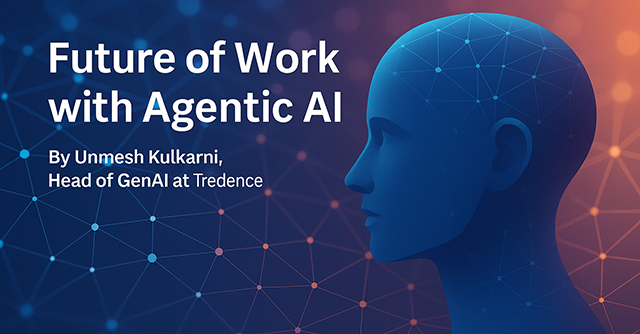
Future of Work with Agentic AI


Even in today’s hyper-connected world, employees are spending an inordinate amount of time sifting through silos of data and businesses are missing out on opportunities because decisions cannot be taken in real-time. However, all that is changing for the better. With the advent of Agentic AI, employees can now focus on things that matter – making decisions & driving impact - and delegate the information retrieval and routine tasks to digital agents & AI-powered assistants. Companies that invest in Agentic AI are winning through this improved productivity & efficiency. Agentic AI is delivering business outcomes beyond productivity gains. It is fast becoming an innovation accelerator and a revenue driver for such companies. In this article, we look at some examples and outline patterns of how enterprises can employ Agentic AI solutions to achieve these business outcomes.
Why Agentic AI matters to you
To understand the impact of Agentic AI, it’s helpful to first understand how it represents an evolution of AI. Over the last few years, companies have deployed statistical models, machine learning and deep learning models, and, more recently, Generative AI applications with LLMs. Agentic AI now adds the ability to solve problems through planning & reasoning, to use tools, and to autonomously make decisions. Agentic AI is essentially Generative AI with better brains and with arms. These new capabilities have made Agentic AI into a transformative technology for driving business outcomes. For example, a leading global consumer packaged goods company was struggling with fragmented workflows, affecting its productivity and growth. They deployed a large language model (LLM) powered operations platform. In the later part of the 2024, they added Agentic capabilities to their GenAI platform. By weaving agency into their core processes, they turned complexity into clarity, silos into synergy, and inefficiency into acceleration.

Another common Agentic application is the replacement of traditional inflexible dashboards with dynamic and natural language insights & recommendation engines. Agents can convert your English query into SQL that data platforms understand and retrieve the right data and insights for the business manager.A clear takeaway is that AI is more than a mere tool, it is a trusted collaborator capable of ushering sweeping changes in the business sector. AI’s ability to work with people by offering support, insights, and even helping with critical decision-making is reshaping business.
According to The ROI of Gen AI study by the National Research Group, commissioned by Google Cloud, 74% of enterprises using Gen AI are already seeing ROI, with 30-35% expecting returns within a year. The study, based on insights from 2,500+ executives, also found that 45% of companies saw employee productivity double, and 85% reported improved user engagement and satisfaction.
Measuring ROI

Since implementing AI systems requires huge investments, companies expect a clear ROI from them. However, these systems provide many intangible benefits and measuring their long-term performance can be challenging. Here’s how companies can measure performance in terms of ROI:
- • Defining clear and measurable objectives that align with business goals (e.g. revenue generation, cost savings, and workflow efficiency)
- • Identifying key metrics linked to these goals. Tracking progress and modifying systems based on early findings & feedback
A 2024 Gartner study found that companies with mature AI measurement frameworks achieve 3.5x better returns on their AI investments, with leading organizations employing both traditional financial metrics and AI-specific indicators like model accuracy improvement over time and decision quality enhancement.
Balancing technology and intuition

Modern enterprises are evolving toward human-AI collaboration where both contribute unique strengths. Models range from augmented intelligence with human decision control to more autonomous systems for well-defined domains.
AI co-pilots augment decision-making by analyzing data intelligently and providing real-time insights. Agentic systems go beyond insights to also provide recommendations and take actions on the users’ behalf. In the B2B sector, for example, Agentic AI systems can offer customized product recommendations, consumer behavior-based promotions, and competitive pricing. The challenge is balancing automation with human intuition—AI handles data processing while humans provide creativity and emotional intelligence.
Ethical considerations

As businesses watch AI progress with bated breath, it is essential to highlight the need for their responsible deployment. Key concerns in this respect are fairness and transparency. Additionally, data privacy & security and AI governance present significant challenges. These issues can be addressed through observability & instrumentation. Enterprises need to collect and monitor Responsible AI metrics covering quality, safety and governance. Companies must address potential biases in their AI models by ensuring diverse data sets, testing rigorously, and implementing guardrails. Organisations must be able to explain how these tools provided a particular recommendation, especially in sensitive sectors such as healthcare or law. All this requires collaboration with the AI ecosystem and access to experts, both in-house and through vendors.
Another concern is AI’s potential impact on jobs. While it can automate certain tasks, it may also create new roles. Companies must focus on reskilling and upskilling the workforce. AI should be viewed as a trusted assistant who can bring out the potential in people.
Future trends and recommendations

There are several exciting developments in AI that can disrupt the market. One of them is multimodal AI, which can understand and process multiple types of data inputs - text, images, videos, etc, and create new content. Another is edge AI, which involves deploying AI close to where data is being collected (e.g. on a smartphone or factory floor), making it faster and more efficient. Integration of AI with Robotics also presents very exciting opportunities as AI interacts with the physical world and robots perform tasks for humans.
AI-driven enterprise automation will only grow, with businesses employing this technology to automate everything from customer service to logistics. AI marketplaces and open-source agentic ecosystems are also expected to play a bigger role, allowing companies to access these tools more easily and collaborate on innovative solutions.
Businesses must start investing now to get a leg up in the AI race. It is important to hire talent & engage with ecosystem players that specialize in AI, build strong cloud infrastructures, and implement robust governance practices.

CIOs and AI leaders can effectively incorporate Agentic AI into their organizations by:
1. Starting with a clear strategic roadmap that aligns AI initiatives with business objectives
2. Driving alignment on AI priorities & business use cases across IT and business, and by being declarative about organizational objectives & AI principles.
3. Establishing an AI Center of Excellence to standardize best practices. Driving the COE to define a comprehensive AI governance framework with oversight.
4. Deploying Agentic AI platforms with observability to monitor model behaviour, quality, and performance
5. Creating robust data pipelines that ensure high-quality, representative training data
6. Delivering early ROI through phased implementation plans starting with high-impact, low-risk use cases
7. Investing in continuous workforce education and AI literacy programs
Your company’s future in this new world will be defined by how quickly it can adapt and capitalise on evolving Agentic AI capabilities. The path forward is clear: businesses that invest in the right technologies and foster a collaborative relationship between humans and AI will lead the way into a future defined by unprecedented growth and innovation.
No Techcircle journalist was involved in the creation/production of this content.

Unmesh Kulkarni
Unmesh Kulkarni is Head of GenAI at Tredence.
